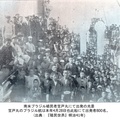"Then, in the middle of the hot summer, Emperor Meiji passed away. At that moment, I felt as if the Meiji spirit had begun and ended with the Emperor. I was struck by the strong feeling that we, who had been most strongly influenced by the Meiji era, were the ones who had survived after that, and that we were ultimately behind the times." (From Kokoro)
I think many Japanese high school students have read this work in their modern Japanese classes. Of course, not the whole story, but only the part "The Teacher's Will," which includes the above passage. Any literary work becomes boring when it becomes a teaching material. I have an obviously false memory of having read it idly for almost an entire semester, and the contents left no impression on me at all. It was only much later, through Jun Eto's critical review, that I found Kokoro interesting.
According to Jun Eto, Soseki, who "had to live as a lonely modern man suffering from the chronic disease of egoism and the impossibility of love," realized that "the 'Meiji spirit' had not completely died out within him" when he encountered the death of the Emperor and the subsequent suicide of Nogi. With this realization, the author began writing "Kokoro" "to make it clear that he was on the side of traditional ethics." (From Jun Eto's "An Intellectual of the Meiji Era")
To be honest, I think I understand the "Meiji spirit," but I don't. Is it too superficial to say that it is a sense of mission in which the state and the self are identified, and that politicians and writers alike naturally share in it, and that they must somehow contribute to building their own nation? Either way, it is a "spirit" that is difficult for most of us Japanese to understand today.
Natsume Soseki was born in 1867, and Mizuno Ryu was born eight years earlier in 1857. Mizuno loudly included the word "Imperial Nation" in the name of his company, and claimed that the Brazilian immigration project was a national project, not something that should be done for personal gain. In today's world, it is rare to find a project that is free from personal gain, so such a statement rings hollow to our ears and seems to be nothing more than a justification for making money. If someone approached us saying, "This is a project that is free from personal gain," who would listen to anything more without being wary? However, when we follow Mizuno's words and actions and hear from people who were close to him during his lifetime, we can only assume that he was serious about it. He was also a holder of the "Meiji spirit" and lived in the same era as Natsume Soseki, and if we think of it that way, we can finally take Mizuno's project at face value.
It was the death of Emperor Meiji and the suicide of General Nogi that made the teacher of Kokoro (Soseki) clearly aware of the end of the "Meiji spirit," but the signs of the end were already there. The victory in the Russo-Japanese War filled the country with an uplifting mood, as if everything that everyone had been aiming for since the Meiji Restoration had been accomplished, and a new type of person who was active in the Taisho era, when self-affirmation and individualism were praised, emerged. Capitalism was also established, and many people were busy pursuing their own interests. On the other hand, the activities of socialists and anarchists also became more prominent. For Mizuno and Soseki's generation, these were days when they could really feel that the times were changing, and the holders of the "Meiji spirit" probably looked at it with a sense of discomfort. The same was true of Emperor Meiji, who was the very embodiment of the "Meiji spirit." The manifestation of this was the "Boshin Imperial Rescript," which called for people not to forget the spirit of the nation's founding. The "Boshin Imperial Rescript" was issued in 1908, the same year as the Kasato Maru.
Mizuno is said to have written a song when he signed an immigration contract with the state of São Paulo.
- Through the years, the ugly roots of the seashore are cut off and the Japanese nadeshiko planted
The Kasato Maru may have been a kind of ark for Mizuno, to transplant the "Meiji spirit" that was being lost to Brazil and to help it survive. The issuance of the "Boshin Imperial Rescript," the conception and realization of the Brazilian immigration project by Mizuno, and what Soseki wrote in "Kokoro" were all expressions of the same situation. The Meiji Emperor issued a direct warning, and Soseki left a work in which the protagonist dies with a "sense of being behind the times" as a sort of epitaph for the "Meiji spirit." Mizuno, who was eight years older than Soseki and had a different character, did not become a "lonely modern man suffering from the chronic disease of egoism and the impossibility of love" and never lost sight of the "Meiji spirit" throughout his life, and chose to act and send Japanese immigrants to Brazil.
It would be a nuisance for someone who is merely involved in immigration history from the outside to create a story based on their own personal feelings. In any case, it is the 100th anniversary of immigration. Perhaps the next milestone will be 200 years. In any case, the origin will always be the Kasato Maru and Mizuno Ryu. It is just an origin, but it is still an origin, and its meaning will surely be reinterpreted and retold many times in the future.
This serialization, which never had a clear goal until the very end, has now come to an end. It is not a summary in particular, but I would like to take over from the end of the previous installment and conclude with the story of Ryu Mizuno and Kasato Maru.
© 2008 Shigeo Nakamura










